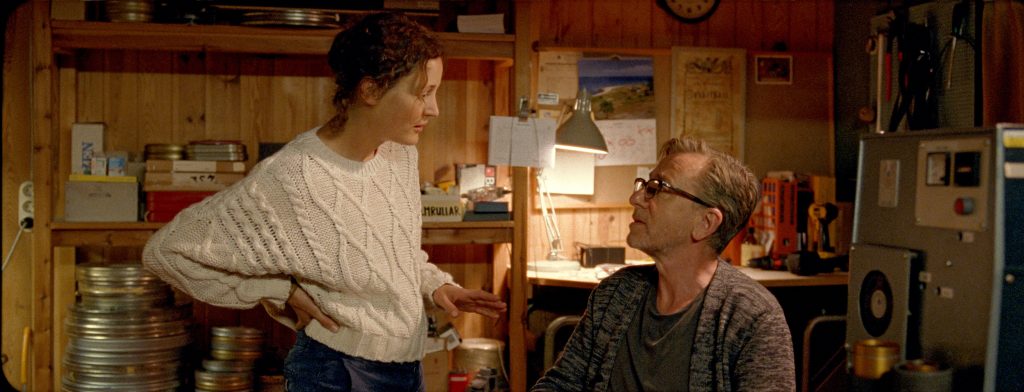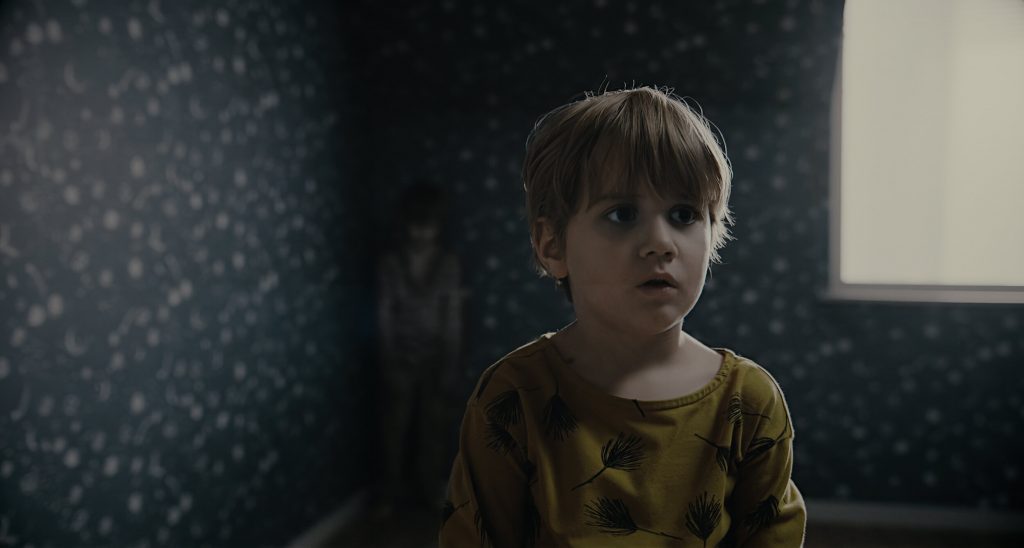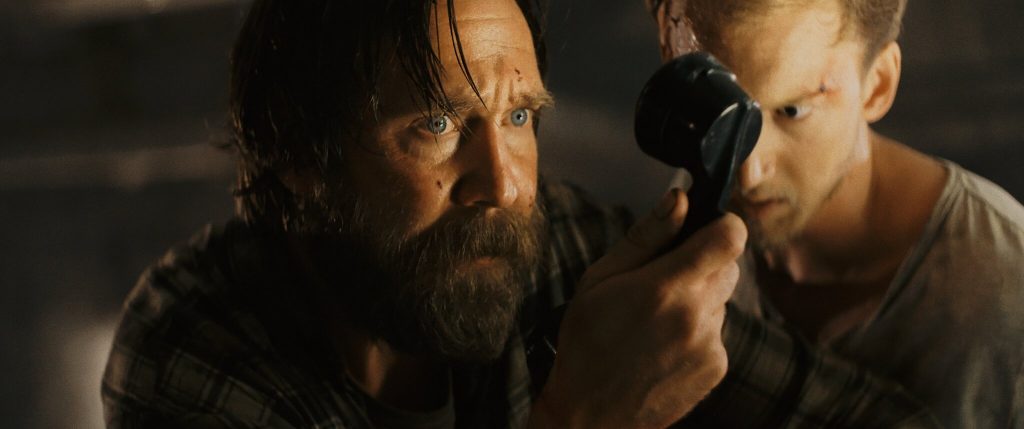October 20, 2021
by Carla Hay

Directed by Mia Hansen-Løve
Some language in Swedish with subtitles
Culture Representation: Taking place in Sweden (primarily on the island of Fårö), the dramatic film “Bergman Island” features an all-white cast of characters representing the working-class, middle-class and wealthy.
Culture Clash: A British film director and his German screenwriter wife have different experiences while on a getaway trip to Fårö (famous for being filmmaker Ingmar Bergman’s home), where she struggles to finish a screenplay, whose plot is depicted in the movie.
Culture Audience: “Bergman Island” will appeal primarily to people who are fans of Ingmar Bergman and to people who are interested in talkative arthouse movies that have a story within a story.

People watching “Bergman Island” will have a better chance of enjoying the movie if they know in advance that it’s more of a low-key “slice of life” character portrait (with a generous serving of Ingmar Bergman history) than a series of dramatic shakeups. Usually, whenever there’s a drama about a married couple going on a getaway trip together, the plot is about some kind of crisis or reckoning that happens in their marriage. That’s not the case with “Bergman Island,” which has a story-within-a-story that’s introduced in the last third of the film.
Written and directed by Mia Hansen-Løve, “Bergman Island” has a meandering quality to it that’s reflective of the leisurely pace that one might have when on a tourist getaway trip. Married couple Tony (played by Tim Roth) and Chris (played by Vicky Krieps) are on this type of trip, which they approach in two very different ways. Tony is a well-known British film director in his late 50s. He’s about 25 years older than Chris, a lesser-known screenwriter who is originally from Germany, but she currently lives in the United States with Tony and their daughter June (played by Grace Delrue), who is about 5 or 6 years old.
Tony is a highly respected “auteur” who’s famous-enough to be recognized in public by film aficionados, but he’s not so famous that paparazzi are following him wherever he goes. Chris and Tony have decided to go without June to Fårö (an island off the coast of Sweden), which is nicknamed Bergman Island, because it’s where Swedish filmmaker Ingmar Bergman famously lived in the later years of his life. The island has become a tourist attraction for Bergman fans who take guided tours of Bergman’s former home and places that he liked to go on the island.
This getaway trip isn’t a complete vacation for Tony and Chris. It’s somewhat of a working trip. Tony has been invited to give a guest lecture, while Chris is trying to get some work done on a screenplay for her next movie. She has writer’s block and is struggling to figure out how to end the film. Viewers will get the impression that Chris and Tony are relatively content with each other, but there’s no real passion in their marriage. They act more like roommates who get along with each other and respect each other.
Chris and Tony aren’t exactly bored with each other, but for a great deal of the trip, they don’t really care to spend a lot of time together. They also make a lot of small talk with each other, as if they’ve run out of meaningful things to discuss. Chris and Tony go on some sightseeing tours together, but at some point, Chris (who gets more screen time than Tony) ends up doing her own activities. It becomes very apparent that Chris and Tony also have very different personalities, which affects how they approach the trip.
A lot of “Bergman Island” is about Chris and Tony meeting some of the local Bergman historians, having dinners with them and going on some sightseeing excursions. However, Chris is a lot more outgoing than introverted Tony. She’s also more interested in meeting new people and having inquisitive conversations with them about their lives, in contrast to to Tony, who limits his conversations with strangers to polite small talk.
Chris is worried about how she’s going to finish her screenplay. Tony doesn’t offer much support because creativity comes easier for him, so he can’t really relate to her writer’s block. It’s implied that Tony doesn’t write a lot of the movies that he directs. He also refrains from giving advice because he thinks that Chris should find her own creative path without interference from him.
While Tony is content to spend time relaxing in their resort room, Chris is more adventurous and spends more time exploring areas on her own and interacting with some of the local people she meets. One of them is a man in his 20s named Hampus (played by Hampus Nordenson), a film student who tells Chris that his grandparents are originally from Fårö. Hampus and Chris end up spending a lot of time alone together, as he shows her places that are not the usual tourist spots.
At one point, Hampus and Chris end up frolicking on a secluded beach with other, in a platonic way. There are hints that Chris and Hampus have a mild attraction to each other, but neither of them acts on it. Hampus and Chris enjoy each other’s company and find out that they have similar tastes in movies and literature.
If “Bergman Island” followed the usual movie formula about a married couple with not much passion in their relationship, someone in Chris and Tony’s marriage would be tempted to commit infidelity on this romantic island. There are hints that Tony has sexual thoughts that he’s not sharing openly with Chris. Shortly after they arrive Fårö, Chris sees in Tony’s journal that he has sketched some drawings of a naked woman in various bondage poses and sexual positions. Next to one of the sketches are these words: “Who are you? You or me?”
Is Tony having an affair? Is he secretly lusting for another woman but hasn’t committed infidelity with her? Or is he just interested in drawing erotic sketches? Don’t expect any answers in this movie. Chris seems somewhat surprised at what she’s discovered in Tony’s journal, but she says nothing to Tony about it because she probably doesn’t want to be accused of snooping.
Chris is more preoccupied with her unfinished screenplay than thinking about infidelity. But it isn’t until the last third of “Bergman Island” that she opens up to Tony and tells him what her screenplay is about, in order to maybe get some feedback or advice from him. When she tells Tony what’s in the screenplay plot so far, the story is depicted on screen in the story-within-a-story part of “Bergman Island.”
The protagonist of Chris’ screenplay is a woman in her 30s named Amy (played by Mia Wasikowska), who’s had a tumultuous on-again/off-again love affair with a guy named Joseph (played by Anders Danielsen Lie), ever since she was 15 and he was 17. It’s unknown if their teenage romance is depicted in Chris’ screenplay. What Chris describes to Tony is the part of the screenplay that is supposed to lead to the ending that Chris has a hard time completing.
After years of not being in contact with each other, Amy and Joseph happen to see each other again because they are guests at a mutual friend’s destination wedding. Amy is now a single mother who is currently not involved in a love relationship. Joseph is not the father of Amy’s child, and Amy doesn’t want to talk about the father of her child.
Meanwhile, Joseph is a never-married bachelor with no children, but he has a serious girlfriend named Michelle back at home whom he says he’s probably going to marry. Amy is not happy to hear this news, because Amy has unresolved feelings for Joseph. It’s enough to say that there are still romantic sparks between Amy and Joseph. Will they or won’t they end up together?
Although all of the principal actors in “Bergman Island” give very good performances (Wasikowska is the standout), the movie seems a little off-kilter by introducing this secondary plot so late in the story. A better narrative structure would have been to weave the secondary story into the main plot in a more seamless way instead of rushing it in toward the last third of the film. Truth be told, Amy and Joseph are a much more intriguing couple than Chris and Tony.
It’s not only because Tony and Chris have settled into a boring marriage. Amy and Joseph just have more interesting things to say to each other. Amy and Joseph are also more passionate with each other and better at expressing themselves, maybe because there’s a lot more at stake with their emotions than “safe” couple Chris and Tony.
“Bergman Island” has some gorgeous cinematography and great scenic shots of Fårö. This movie should be a treat for people who are Bergman fans, since there are plenty of references to his work and personal life in the movie. Without the subplot about Amy and Joseph, “Bergman Island” would not be as compelling to watch. Don’t be surprised if you almost wish that Amy and Joseph’s story had been the main plot, because it seems like Amy and Joseph’s screen time ends too soon.
IFC Films released “Bergman Island” in select U.S. cinemas on October 15, 2021.







